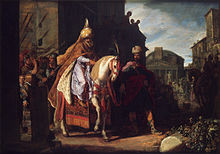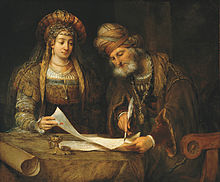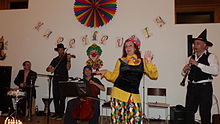Purim
The festival of Purim ( Hebrew purim, plural ofפור pur , German ' Los, Schicksal ' , originally from the Akkadian word pūru, Yiddish Purim or Pirem ) is a Jewish festival that commemorates the rescue of the Jews in the Achaemenid Empire .
origin
Purim is a festival that commemorates the salvation of the Jewish people from imminent danger in the Persian diaspora . According to the Book of Esther , Haman , the highest government official of the Persian king, tried to murder all Jews in the Persian Empire in one day. Queen Esther, however, brings salvation through fasting and prayer.
On this occasion, a service is celebrated in the synagogue , which is usually not overly serious, the whole process is aimed at joy. The fixed scroll of the Book of Esther is also read out. Whenever the name Haman is mentioned, the children present should make as much noise as possible with boos, rattles and ratchets ( Yiddish Grägger ). This is based on God's command to erase the name of Amalek , Haman's ancestor, after Amalek obstructed Israel on their way to the Promised Land . His name thus became a symbol of hostility towards Jews .
In the Book of Esther it is described that Haman selfishly took advantage of his office as the highest government official of the Persian King Achaschwerosch (Hebrew for Xerxes I ). The royal servants had to kneel before him. Ester's cousin and adoptive father Mordechai refused as a Jew. Haman is said to have decided to kill all Jews in revenge. The exact time, the 13th Adar , was determined by lot - hence the name Purim (= lots). Esther, the queen, had campaigned for the king to save the Jews, whom he allowed to defend themselves. Haman was killed along with around 75,000 other residents of the Persian Empire.
Possibly there is a connection with the Zoroastrian festival frawardīgān , which u. a. by Herodotus as magophonia - the "murder of the skimmed " - is reported (3.68-79) and the Zoroastrian Persians the rule of Magers Gaumata and the subsequent rise of Darius I imagined.
Day of celebration
The festival of Purim is celebrated on the 14th or 15th day of the month of Adar in the Jewish calendar . For the corresponding date in the civil calendar, see Jewish calendar # The dates of the Jewish feast days for the years 5779 to 5783 . Every feast day begins the evening before, because in the Jewish calendar the day lasts from the evening before to the evening of the day - not from midnight to midnight. The beginning of the evening is denoted by the word (Hebrew ערב evening) Erev .
Purim is celebrated on Adar 14 throughout Israel and in the Diaspora. In Jerusalem and in Jericho as well as in the then (Persian) capital Susa as well as in all cities that were surrounded by a wall in the time of Joshua the son of Nun, the festival of Purim is celebrated on Adar 15. This Purim is called Shushan Purim or Purim of the cities due to the fact that it is only celebrated in the cities formerly surrounded by walls - in contrast to the Purim of the provincial cities , which is celebrated in open cities. In cities where there are doubts about the date of their creation and walls around them - e.g. B. Akko , Tiberias , Jaffa - Purim is celebrated on both the 14th and 15th Adar.
The reason is as follows: On Adar 13, the Jews waged a struggle for rescue and redemption against their enemies, and on Adar 14 they rested from it. That is why this day is considered a day of joy and feast. In contrast, the Jews in the capital Susa were given permission to fight their enemies on both Adar 13 and 14, and only on Adar 15 did they rest from the fighting. Therefore, the 15th Adar was set as the day of joy for the Jews in the capital. In order to honor the land of Israel, which at that time was barren and empty, the Jewish scholars decided to transfer something of the uniqueness of the capital Susa to the cities in the land of Israel, which were walled in the time of Joshua.
In Jewish leap years the adar is doubled; In this case Purim takes place in the second Adar and in the first Adar Purim qatan (little Purim) is celebrated. Unlike in rabbinic Judaism, the Karaites celebrate Purim in the first Adar.
Purim meschulash
Purim meschulash (three times Purim) : It can happen that the Purim festival lasts for a total of three days, namely when the 15th Adar falls on a Sabbath in a city surrounded by walls. Then the following applies:
- 14. Adar: Reading of the megilla and gifts for the poor,
- 15. Adar ( Sabbath ): prayer Al ha-Nissim , reading the Torah,
- 16. Adar: Feast and gifts to the next of kin.
Seven Duties to Purim
- Complete reading of the Book of Moses and Esters (Megillate Esters). You must not miss a word, so the reader must at the points where the congregation rattles, rattles or makes other noises when hearing the name Haman ("Haman knocking", knocking on the desk, sometimes with special hammers) take a break until the noise subsides.
- Gift items to the next of kin or friends ( "Mischloach Manot" or "Schlachmones" ). The minimum is a program that consists of at least two different dishes. The shipment must be sent on the holiday itself, not the evening before.
- Gifts for the poor, "Matanot Laewjonim". The minimum is two gifts to two arms, i.e. H. one gift per person. Donations of money are common and encouraged.
- Reading the Torah.
- Saying "About the miracles" in prayer and grace.
- Feasts and Joy, “Seudat Purim”: Purim is a day that Jews celebrate with food and drink. In connection with this, one must also drink a lot of wine. And the Jewish scholars said: "Everyone has to drink so much wine that he can no longer distinguish between 'Cursed be Haman' and 'Praise be to Mordechai'" - as many "l'Chaims" as possible (toasting "Auf's Leben!") drink and eat " Hamantaschen ".
- Ban on funeral speeches and fasting.
regional customs
The customs associated with Purim are based on the following passage from the Book of Esther :
“Mordecai wrote down everything that had happened. He sent letters to all Jews in all the provinces of King Artaxerxes near and far, making it their duty to observe the fourteenth and fifteenth days of the month of Adar as a feast day each year. These are the days when the Jews had rest again from their enemies; it is the month when her grief turned into joy and her sadness turned into happiness. They should celebrate them as feast days with food and drink and give each other presents, and they should also give presents to the poor. "
The people are entertained with a special Purim literature, as well as amused with masks and disguises. Performances and representations (“Purim Games”) like those of the “Rabbi of Purim”, capricious antics, sometimes parodies of biblical events and characters were allowed once a year, just for Purim - and the parishioners used them to target the dignitaries of the community to take and "settle with them". Colorful dresses and costumes can be seen on the streets like in carnival. In Israel these fun, colorful processions are called ad-lo-jada , "until you don't know anymore" (what you are doing).
The focus is on dressing up in colorful traditional costumes and organizing parades. The mood is exuberant. Gifts are exchanged and large quantities of (especially sweet) festive dishes - such as hamantaschen filled with poppy seeds, nuts or chocolate or Nunt - from Jewish cuisine are consumed. It is also common to eat boiled beans and peas. Every ethnic group, every community has developed its own traditions with special dishes and special entertainment.
There are many reasons why masks and costumes are worn on Purim. Some details can be traced back to the mutual influence with the Christian carnival , which takes place around the same time of year. A stronger inner-Jewish justification is based on the fact that the book of Esther is one of the books in the Bible in which the expression God is not once mentioned directly, but only in combination of words. The Jewish tradition interprets this characteristic to mean that even God disguises himself for Purim. Nevertheless, the unmistakable presence of Divine Providence is palpable in the extensive details of the narrative. In the same way, the concept of the mask is meant to express the way in which God directs the events of Purim. He undoubtedly directed them, although not visibly. In the past, Jews disguised themselves as Esther, Haman, etc. Due to the cheerful mood of the holiday, other costumes were also worn.
Purim Vintz
Local days of remembrance for similar occasions are also called “Purim”. The Jewish community Frankfurt am Main z. B. has been celebrating the festival of Purim Vintz (Purim Vincenz) every year since 1616 on the 20th of Adar, which commemorates the suppression of the anti-Jewish Fettmilch uprising in 1614 and the solemn return of the previously expelled community to Judengasse .
Literary aftermath
The ester material, which makes the heightening of humility and the overthrow of pride evident, has been dramatized repeatedly since the 16th century. a. by Hans Sachs , Lope de Vega , Racine ( Esther ), Grillparzer and Max Brod .
Purim under National Socialism
The National Socialists often referred to the Purim festival, accusing the Jews of the counter-violence against Haman and his followers reported in the Book of Esther. In the 1934 anti-Semitic inflammatory weekly newspaper Der Stürmer published by Julius Streicher , for example, it was claimed that Jews preached hatred and murder against non-Jews during excessive drinking at Purim . Jews would pierce a Haman doll that they also identified with Adolf Hitler . Gauleiter Julius Streicher claimed in a speech given on November 10, 1938, the day after the night of the Reichspogromnacht , that the Jews had murdered 75,000 Persians and that by starting a war against Germany they had inflicted a similar fate on the German people and introduced a new German festival of Purim if they hadn't been forestalled by the pogroms. On January 30, 1944, Hitler himself drew a connection between himself and Haman and between a defeat of Nazi Germany and a "second Purim". When he was executed on October 16, 1946, Streicher said goodbye with the words “Heil Hitler! This is the festival of Purim in 1946. I am going to God. The Bolsheviks will one day hang you too. "
During the time of the Holocaust , the Nazis repeatedly chose the festival of Purim for attacks on Jews. In 1942 ten Jews were hanged on Purim in Zduńska Wola, Poland , "to avenge Haman's sons". In 1943 ten Jews from the Piotrków Trybunalski ghetto were shot on the same grounds , and over a hundred Jewish doctors and their families were shot on that year's Purim festival near Częstochowa and Szydłowiec .
See also
Purim festival dates
Public holiday in Israel :
| Jewish year | Gregorian date |
|---|---|
| 5779 | March 21, 2019 |
| 5780 | March 10, 2020 |
| 5781 | February 26, 2021 |
| 5782 | March 17, 2022 |
| 5783 | March 7, 2023 |
If Purim falls on a Friday, the celebrations last for three days.
Jewish holidays begin at sunset on the evening before the specified day.
literature
- Karl Heinz Burmeister : Hohenems Purim, a Jewish carnival in 1811. In: bodenseebibliotheken.eu / writings of the association for the history of Lake Constance and its surroundings. Pp. 131-138 , accessed on January 3, 2019 (105th year 1987).
- Elliott Horowitz: Reckless Rites. Purim and the Legacy of Jewish Violence . Princeton University Press, 2006.
Web links
- Jewish Holidays - Purim. In: hagalil.com. Retrieved January 3, 2019 (numerous articles and presentations).
- Michael Rosenkranz: Purim - festival of victory over the adversaries. In: talmud.de. Retrieved January 3, 2019 .
- Purim at a Glance - The Mitzvot, Explanations, Customs & the Day Before Purim. In: de.chabad.org. January 10, 2007, accessed January 3, 2019 .
- Purim Songs & Stories - Purim Music, Songs, Stories and more ... In: synagoge-karlsruhe.de. Retrieved January 3, 2019 .
- Krista and Johannes Gerloff : Purim, Israel's Carnival. In: israelnetz.com. March 4, 2015, accessed January 3, 2019 .
- Tali Konas: Masks - A film by Amitai Arnon and Esther Bires. In: Rosa Luxemburg Foundation Israel Office. May 15, 2017, accessed on November 15, 2017 (The documentation accompanies an Israeli siblings over 12 years of age while celebrating the Purim festival).
Individual evidence
- ^ S. Shaked: Book of Esther . In: Encyclopædia Iranica . online ed. 2010.
- ↑ David Asheri, Alan Lloyd, Aldo Corcella: A commentary on Herodotus. Books I-IV. Oxford University Press, Oxford u. a. 2007, ISBN 978-0-19-814956-9 , p. 471.
- ^ Susanne Galley: The Jewish year. Celebrations, memorials and holidays. Beck, Munich 2003, ISBN 3-406-49442-0 , p. 118 ( Beck'sche series 1523).
- ↑ "The Night of Murder" - The secret of the Jewish festival of Purim is revealed . In: Der Stürmer , March 1934, No. 11; humanist.de
- ↑ Randall L. Bytwerk: Landmark Speeches Of National Socialism . College Station, Texas A&M University Press, 2008, p. 91.
- ^ A b Elliott Horowitz: Reckless rites: Purim and the legacy of Jewish violence . Princeton University Press, Princeton NJ 2006, p. 91.
- ↑ Short biography: Julius Streicher (1885-1946). In: Spiegel Online . November 9, 2000, accessed January 3, 2019 .
- ↑ 20th Century Jewish Religious Thought: Original Essays on Critical Concepts, Movements, and Beliefs . Jewish Publication Society of America, Philadelphia 2009, p. 948.






